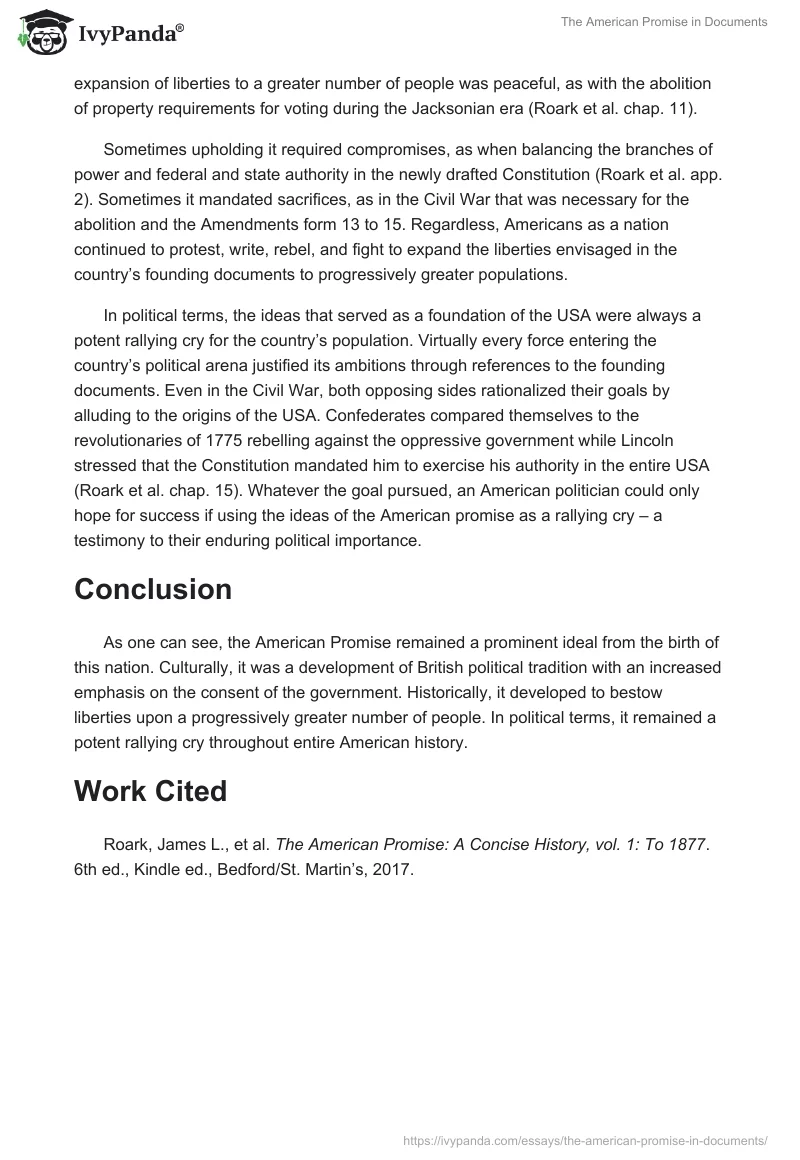Introduction
The ideas of liberty, equality, and human rights were central to American political consciousness ever since the emergence of the country. Such documents as the Declaration of Independence or the Constitution of the United States serve as a testimony to this importance. Culturally, their ideas were a continuation of British political tradition, historically, Americans developed them to create a more encompassing vision of liberty, and politically, these notions often served as a potent rallying cry.
Main body
Neither the Declaration of Independence nor the Constitution emerged out of thin air – instead, they were a product of the long-running British political tradition. The emergence and development of the colonial society that eventually led to the creation of the USA were guided by unmistakably British fashions “in ideas, faith, and politics” (Roark et al. chap. 5). American political consciousness went back to the Magna Carta and English philosopher John Locke –a co-author of the Fundamental Constitutions of Carolina – stressing that authority required the consent of the governed (Roark et al. chap. 3).
The idea that the government should respect their private interests – for instance, uphold the freedom of speech and do not station soldiers in their houses – meant a lot for the people of the early USA. This importance is especially clear in the Bill of Rights containing the first ten Amendments to the Constitution.
Historically speaking, American society not merely declared the values of liberty, equality, and human rights in its founding documents, but strove to broaden their application. The original political constitution of the country was a far cry from the proclaimed belief that “that all men are created equal” (Roark et al. app. 1). African American slaves – and, initially, non-property-owning citizens were excluded from political life, thus failing the true spirit of the American Promise. Sometimes the expansion of liberties to a greater number of people was peaceful, as with the abolition of property requirements for voting during the Jacksonian era (Roark et al. chap. 11).
Sometimes upholding it required compromises, as when balancing the branches of power and federal and state authority in the newly drafted Constitution (Roark et al. app. 2). Sometimes it mandated sacrifices, as in the Civil War that was necessary for the abolition and the Amendments form 13 to 15. Regardless, Americans as a nation continued to protest, write, rebel, and fight to expand the liberties envisaged in the country’s founding documents to progressively greater populations.
In political terms, the ideas that served as a foundation of the USA were always a potent rallying cry for the country’s population. Virtually every force entering the country’s political arena justified its ambitions through references to the founding documents. Even in the Civil War, both opposing sides rationalized their goals by alluding to the origins of the USA. Confederates compared themselves to the revolutionaries of 1775 rebelling against the oppressive government while Lincoln stressed that the Constitution mandated him to exercise his authority in the entire USA (Roark et al. chap. 15). Whatever the goal pursued, an American politician could only hope for success if using the ideas of the American promise as a rallying cry – a testimony to their enduring political importance.
Conclusion
As one can see, the American Promise remained a prominent ideal from the birth of this nation. Culturally, it was a development of British political tradition with an increased emphasis on the consent of the government. Historically, it developed to bestow liberties upon a progressively greater number of people. In political terms, it remained a potent rallying cry throughout entire American history.
Work Cited
Roark, James L., et al. The American Promise: A Concise History, vol. 1: To 1877. 6th ed., Kindle ed., Bedford/St. Martin’s, 2017.


